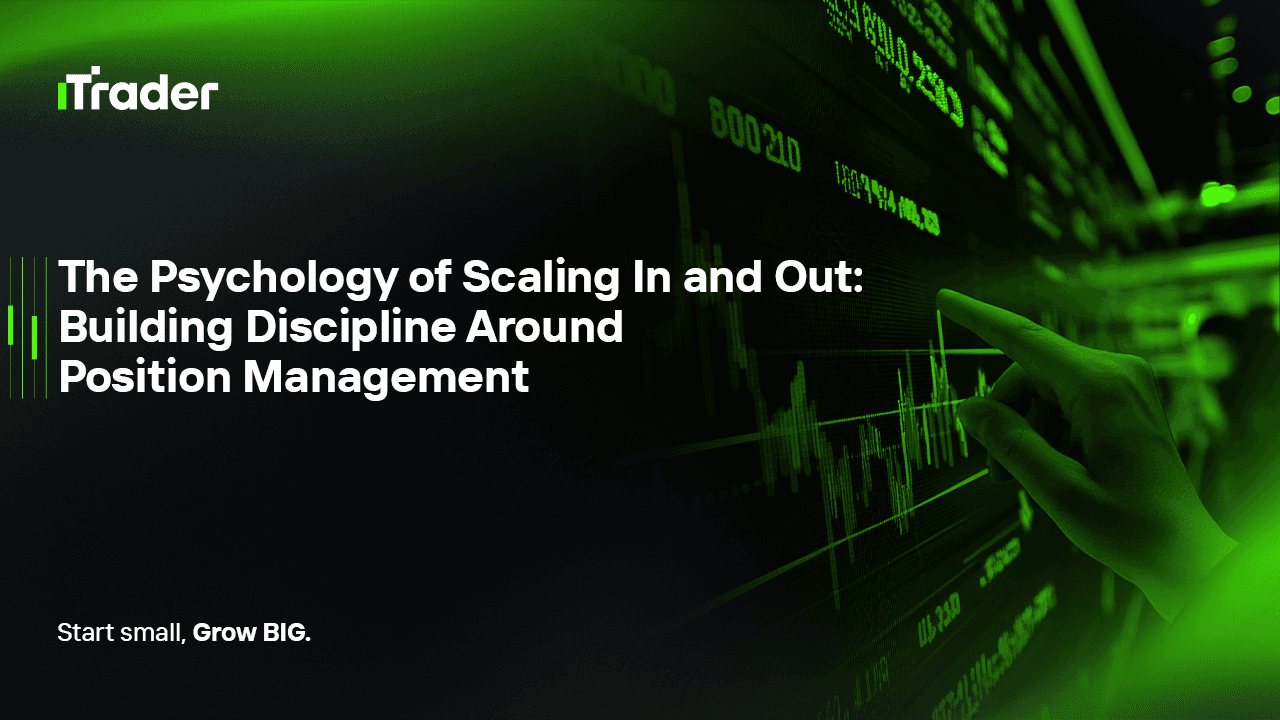2025-09-23
Ask any trader what matters most, and many will say “finding the perfect entry.” But if you’ve been trading forex long enough, you know the truth: the entry is only the beginning. The real battle starts after you’re in the trade.
This is where position management comes in. It’s the art—and discipline—of adjusting your exposure as the trade unfolds. Do you add more when the market is moving in your favor? Do you reduce size to protect profits? Or do you freeze, second-guess, and end up turning a good trade into a missed opportunity?

The answers lie in how well you apply two powerful techniques: scaling in and scaling out. Done right, they can transform your equity curve. Done wrong, they can sabotage even the best setups.
Let’s break them down, not just technically, but from the psychological perspective that often separates winning traders from inconsistent ones.
At its core, position management is about controlling your size, risk, and profit distribution as the market evolves.
Sounds simple, right? The reality is far from it. The mechanics are easy—the psychology is not. That’s why so many traders either misuse these tools or avoid them altogether.
Scaling in is about pressing your advantage. Instead of throwing all your capital in at once, you start small, and only increase size when the trade proves itself.
For example:
Greed creeps in fast here. Many traders confuse scaling in with averaging down—adding to losers in the hope of recovery. That’s not scaling in; that’s gambling. True scaling in happens only when you’re already ahead.
Another common pitfall: over-adding. A trade moves slightly in your favor and you pile in aggressively, only to get shaken out by a minor pullback. Discipline is what keeps scaling in a weapon, not a liability.
Scaling out is about reducing exposure as the trade matures. Instead of closing everything too early or holding everything too long, you strike a balance.
Example:
The danger with scaling out is doing it too early. If you close half the position for peanuts, you rob yourself of the trade’s true potential. On the flip side, refusing to scale out at all can mean watching a winning trade reverse and wipe out your gains.
The skill lies in defining clear rules: when, how much, and under what conditions to scale out. Without that framework, emotions take over.
The technical rules are easy to write down. The execution is another story.
Here’s what tends to go wrong:
To counter this, you need structure:
A trader buys EUR/USD with 1 lot, stop 50 pips. After +50 pips in profit, they add 0.5 lot. At +100 pips, they close the initial 1 lot, trail the remaining 0.5 lot, and secure a total of +3R.
The key? They only added after confirmation and managed risk carefully.
Another trader buys 1 lot. The trade drops 40 pips against them. Instead of taking the stop, they add another 1 lot to “average down.” When the stop hits, the loss is double what they planned.
That’s not position management—it’s emotional trading disguised as strategy.
Here’s how to bring discipline to scaling in and out:
Trading is a probability game. A single trade means nothing. What matters is how your equity curve looks after 100, 200, or 500 trades.
Scaling in and out, applied with discipline, smooths that equity curve. It reduces volatility in your results, protects you from emotional swings, and lets you compound gains more effectively.
The traders who succeed aren’t the ones who catch one big move—they’re the ones who stay in the game long enough for their edge to play out. Position management is what keeps you in the game.
Scaling in and scaling out are more than just trade management tactics. They are mirrors that reveal your psychology.
With clear rules and discipline, these tools transform you from reacting emotionally to trading with intent. They don’t just help you manage positions—they help you manage yourself.
That’s the real edge.
© 2025 iTrader Global Limited | หมายเลขทะเบียนบริษัท: 15962
iTrader Global Limited ตั้งอยู่ที่ Hamchako, Mutsamudu, เกาะปกครองตนเอง Anjouan, สหภาพคอโมโรส และได้รับใบอนุญาตและอยู่ภายใต้การกำกับดูแลของคณะกรรมการหลักทรัพย์แห่งคอโมโรส ภายใต้หมายเลขใบอนุญาต L15962/ITGL
iTrader Global Limited ดำเนินการภายใต้ชื่อทางการค้า “iTrader” และได้รับอนุญาตให้ดำเนินกิจกรรมการซื้อขายฟอเร็กซ์ โลโก้ เครื่องหมายการค้า และเว็บไซต์ของบริษัทเป็นทรัพย์สินเฉพาะของ iTrader Global Limited
บริษัทย่อยอื่น ๆ ของ iTrader Global Limited ได้แก่ iTrader Global Pty Ltd หมายเลขทะเบียนบริษัทออสเตรเลีย (ACN): 686 857 198 โดยบริษัทนี้เป็นตัวแทนที่ได้รับอนุญาต (หมายเลขตัวแทนบริการทางการเงินของออสเตรเลีย (AFS): 001315037) ของ Opheleo Holdings Pty Ltd (ใบอนุญาตบริการทางการเงินของออสเตรเลีย (AFSL): 000224485) ซึ่งมีที่อยู่จดทะเบียนอยู่ที่ Level 1, 256 Rundle St, Adelaide, SA 5000 ข้อจำกัดความรับผิดชอบ: นิติบุคคลนี้ไม่ใช่ผู้ออก และไม่รับผิดชอบต่อผลิตภัณฑ์ทางการเงินที่ซื้อขายบนหรือผ่านเว็บไซต์นี้
คำเตือนความเสี่ยง: การซื้อขาย CFD มีความเสี่ยงสูงต่อการสูญเสียเงินทุนอย่างรวดเร็วเนื่องจากเลเวอเรจ และอาจไม่เหมาะสมกับผู้ใช้ทุกคน
การซื้อขายกองทุน CFD และผลิตภัณฑ์ที่มีเลเวอเรจสูงอื่น ๆ ต้องการความรู้เฉพาะทาง
จากผลการวิจัยพบว่า 84.01% ของผู้เทรดที่ใช้เลเวอเรจประสบกับการขาดทุน
โปรดตรวจสอบให้แน่ใจว่าคุณเข้าใจความเสี่ยงทั้งหมด และพร้อมที่จะสูญเสียเงินทุนก่อนที่คุณจะเข้าร่วมการซื้อขายที่มีเลเวอเรจ
iTrader ขอประกาศว่า บริษัทจะไม่รับผิดชอบต่อความเสี่ยง ความเสียหาย หรือการสูญเสียใด ๆ ที่เกิดขึ้นจากการซื้อขายแบบมีเลเวอเรจต่อบุคคลหรือนิติบุคคลใด ๆ ทั้งสิ้น
ข่าวสารและข้อมูลที่ปรากฏบนเว็บไซต์นี้มีไว้เพื่อวัตถุประสงค์ทางการศึกษาเท่านั้น ผู้ใช้ควรตัดสินใจทางการเงินอย่างอิสระและโดยใช้ข้อมูลอย่างรอบคอบ
ข้อจำกัด: iTrader ไม่ได้มุ่งเป้าเว็บไซต์หรือบริการไปยังผู้อยู่อาศัยในประเทศที่กฎหมายหรือข้อบังคับห้ามไม่ให้มีการทำธุรกรรมดังกล่าว
หากคุณอาศัยอยู่ในเขตอำนาจที่การใช้เว็บไซต์หรือบริการนี้ถูกจำกัด คุณต้องรับผิดชอบในการปฏิบัติตามกฎหมายท้องถิ่น
iTrader ไม่รับประกันว่าเนื้อหาบนเว็บไซต์ของบริษัทจะเหมาะสมหรือถูกต้องตามกฎหมายในทุกพื้นที่